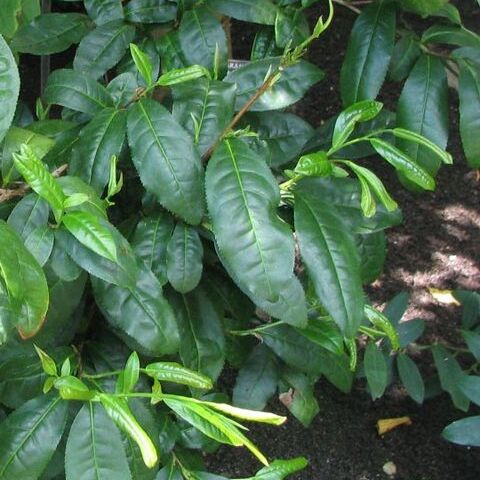Trees (up to 20 m high) or shrubs, usually evergreen, indumentum of unicellular trichomes or glabrous. Leaves spiral or distichous, simple, petiolate or sessile (appearing petiolate due to the decurrent base), often asymmetric, coriaceous, margins serrate (rarely entire), with small deciduous bristle-like glands terminating each tooth, venation pinnate more or less craspedromous or obscure (not in Australia), exstipulate. Flowers solitary, occasionally appearing fasciculate or racemose, axillary, hermaphroditic or unisexual (not in Australia), sepaloid, 2 prophylls or 2–7 involucral bracteoles intergrading with the calyx and corolla making the perianth parts indistinguishable from one another. Calyx with 5 or 6 or rarely more sepals, these imbricate, basally connate or distinct, often persistent in fruit. Corolla with 5–6 (–10) petals, these imbricate, distinct or slightly basally connate. Stamens 20–40, free or rarely basally to fully connate, frequently adnate to base of corolla, centrifugal, with 5 primordia opposite each petal or with ring primordium in 2–5 whorls. Anthers articulated, versatile or dorsifixed, opening by longitudinal slits, staminodia present in female flowers. Gynoecium (3–) 5 (–10), syncarpous, ovary superior, occasionally hirsute, 3–5-loculate. Styles 1, lobed, or 3–5, capitate. Fruit a spheroidal, woody, loculicidal capsule c. 2 cm long, generally with a persistent calyx, columella persistent. Seeds few, 0.4–2 cm long, flattened, oblong apical wings present or absent.
Shrubs or trees, glabrous or hairy. Leaves persistent or deciduous, alternate [spiral or distichous], simple; stipules absent; petiole present; blade coriaceous or chartaceous, margins toothed [entire], teeth deciduously gland-tipped. Inflorescences axillary, flowers solitary [2-3], bracteate. Flowers bisexual; perianth and androecium hypogynous; sepals [4-]5[-14], distinct or connate proximally, concave, relatively thick; petals 5(-8)[-14], distinct or connate proximally; nectary disc absent; stamens (50-)75-125(-150), in 1-5 bundles or not bundled, connate proximally or distinct, usually adnate to petals or corolla; anthers versatile [basifixed], 4-locular, dehiscent by longitudinal slits; pistils 1, [3-](4-)5(-6)[-10]-carpellate; ovary superior, [3-]5[-10]-locular; placentation primarily (falsely; H. Keng 1952) axile; ovules anatropous (campylotropous), bitegmic, tenuinucellate; styles 1 or 5[-6], simple [branched]; stigmas 1-5[-7], usually lobed. Fruits capsular, woody, dehiscence loculicidal and septicidal, [rarely irregular or fruits drupaceous]. Seeds 2-20, reddish brown to dark brown, compressed or lenticular [angular], sometimes winged, (testa vascularized, ± lignified); embryo straight, rarely curved; endosperm nuclear, usually slight.
Trees or shrubs, usually evergreen. Leaves alternate or spirally arranged, exstipulate, often toothed. Flowers unisexual or hermaphrodite, regular, usually solitary, rarely paniculate, racemose or cymose, frequently large and showy. Sepals 5(–7), free or slightly joined, imbricate. Petals 5(–10), free or slightly joined, imbricate or contorted, spreading except in Melchiora. Stamens usually numerous, in several whorls, hypogynous, free, shortly connate or epipetalous. Ovary superior, 1–5-locular ; ovules 1-many in each locule, axile ; styles free or connate
Stamens ? or rarely definite, hypogynous, free or fasciculate or connate at the base to form a tube, sometimes adnate to the base of the petals; anthers versatile or basifixed, often with an apiculate connective-prolongation, dehiscing longitudinally or rarely at first by apical pores; disk absent
Flowers axillary, solitary or sometimes paired or in fascicles, rarely cymose or in elongated racemes, actinomorphic, bisexual or rarely unisexual, often with one or more pairs of bracteoles below the calyx
Ovary superior (rarely apparently semi-inferior), syncarpous, sessile, (1) 2–5 (7)-locular; styles free or united; ovules 2 or more (rarely 1) in each loculus, axile, sometimes pendulous
Fruit a loculicidal capsule (often leaving a persistent central column) or a dry or rarely fleshy berry or drupe, indehiscent or rarely irregularly dehiscent at the apex
Seeds 1–? endosperm abundant, scanty or absent; embryo straight or curved, sometimes folded or spirally twisted
Leaves alternate or spiral, simple, usually coriaceous, exstipulate
Petals usually 5, imbricate, hypogynous, free or shortly connate
Sepals usually 5, imbricate, free or shortly connate
Trees or shrubs

